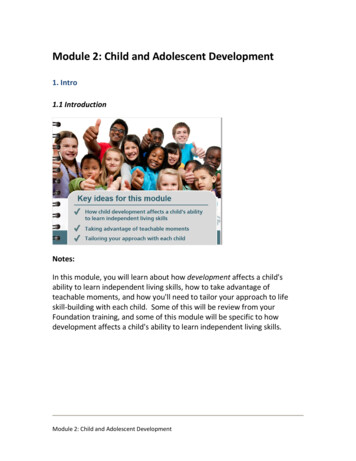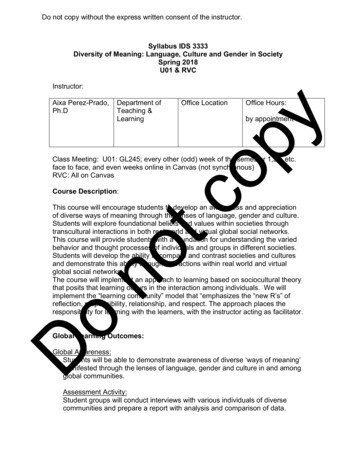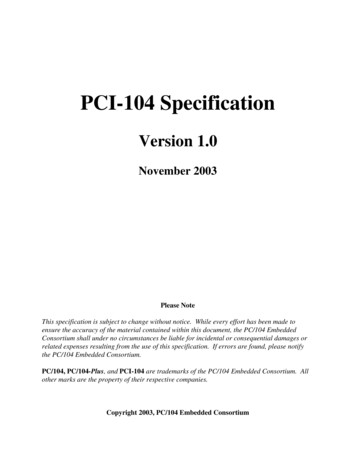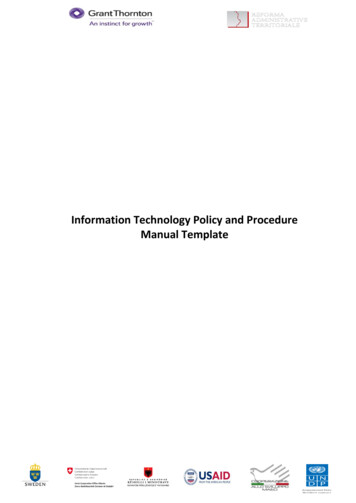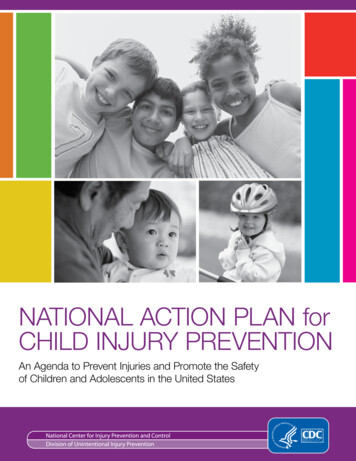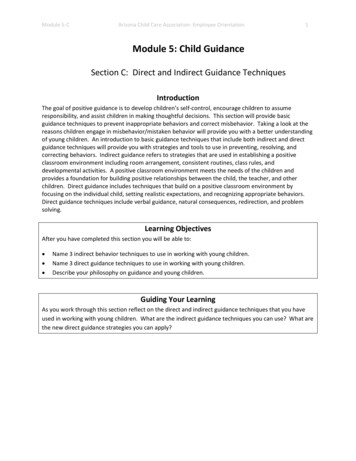
Transcription
Module 5-CArizona Child Care Association: Employee Orientation1Module 5: Child GuidanceSection C: Direct and Indirect Guidance TechniquesIntroductionThe goal of positive guidance is to develop children’s self-control, encourage children to assumeresponsibility, and assist children in making thoughtful decisions. This section will provide basicguidance techniques to prevent inappropriate behaviors and correct misbehavior. Taking a look at thereasons children engage in misbehavior/mistaken behavior will provide you with a better understandingof young children. An introduction to basic guidance techniques that include both indirect and directguidance techniques will provide you with strategies and tools to use in preventing, resolving, andcorrecting behaviors. Indirect guidance refers to strategies that are used in establishing a positiveclassroom environment including room arrangement, consistent routines, class rules, anddevelopmental activities. A positive classroom environment meets the needs of the children andprovides a foundation for building positive relationships between the child, the teacher, and otherchildren. Direct guidance includes techniques that build on a positive classroom environment byfocusing on the individual child, setting realistic expectations, and recognizing appropriate behaviors.Direct guidance techniques include verbal guidance, natural consequences, redirection, and problemsolving.Learning ObjectivesAfter you have completed this section you will be able to: Name 3 indirect behavior techniques to use in working with young children.Name 3 direct guidance techniques to use in working with young children.Describe your philosophy on guidance and young children.Guiding Your LearningAs you work through this section reflect on the direct and indirect guidance techniques that you haveused in working with young children. What are the indirect guidance techniques you can use? What arethe new direct guidance strategies you can apply?
Module 5-CArizona Child Care Association: Employee Orientation2NOTE: The information contained in these sections are partial summaries of the DHS Child CareLicensing Regulations, are not intended to replace or provide an official interpretation of the ArizonaAdministrative Code and Arizona Revised Statutes for Child Care Facilities.Summary of Key Arizona Child Care Licensing StandardsArticle 5 Facility Program and EquipmentR9-5-510 Discipline and GuidanceA. Requires that a child care program develops and implements consistent and reasonable behavioralguidelines. Teachers are expected to model and encourage positive conduct and personal control,explain the reasons for behaviors that are not appropriate, and provide an alternative behavior. If achild presents a threat to self or others, staff may hold the child until the child regains composure.B. Regulations do not allow types of discipline that result in harm to the health, safety, or welfare of anenrolled child including any type of physical punishment and abusive language.C. A child may be separated from the rest of the group for unacceptable behavior. The child may not beseparated from the group for more than 10 minutes without a teacher talking with the child.Definition of “guidance” means the ongoing direction, counseling, teaching, or modeling of generallyaccepted social behavior through which a child learns to develop and maintain the self-control, selfreliance, and self esteem necessary to assume responsibilities, make daily living decisions, and liveaccording to generally accepted social behavior.Guiding Young Children’s BehaviorEarly childhood teachers enjoy working with young children as they learn new things, use theircreativity, interact with others, and communicate their stories. Most early childhood teachers do notenjoy the challenges presented by children’s inappropriate behaviors. Unfortunately, misbehavior ormistaken behavior is an unavoidable part of working with children. Remember, all skills need to bepracticed before they are mastered.Early childhood teachers play an important role in guiding the behavior of young children. Positive childguidance and discipline promote children’s self-esteem, help children develop responsibility, andinfluence children in making thoughtful choices.Teaching young children appropriate behavior and self-discipline is a difficult task that requires: PatienceThoughtful attentionCooperationKnowledge of the childA reflective knowledge of one’s personal struggles with discipline issues
Module 5-CArizona Child Care Association: Employee Orientation3Early childhood teachers who effectively guide and foster children’s appropriate behavior may spendless time in resolving misbehavior. The ultimate goal is to have children learn to self-regulate and guidetheir own behavior.Definitions of Behavior TermsGuidance teaches children to solve their problems in socially acceptable ways (Gartell) and refers to allmethods that are used to encourage children’s positive behavior.Positive guidance methods are based on the children’s development and are focused on maintainingthe child’s self-esteem and dignity.Discipline methods help children learn to control their behavior and act according to their ideas of whatis right and wrong. People often mistake discipline for punishment.Punishment is used to penalize the child for making a wrong choice and is detrimental to building selfesteem. It fosters resentment and retaliation. It may make the child stop the inappropriate behavior forthe moment but it will not be a learning experience.Misbehavior or Mistaken BehaviorThe concept of mistaken behavior provides a different perspective of children’s behavior. Children areat the beginning of a lifelong learning process making mistakes is part of the process. Taking theperspective of mistaken behavior requires recognizing that children are learning how to interact andadapt to the world. Part of the early childhood teacher’s responsibility is to guide children’s learningand behavior. Just as children make mistakes in learning activities, they will make mistakes ininteracting with other children, following rules, or making decisions; it is the teacher’s role is to guidethe child in learning to choose acceptable behaviors and make thoughtful decisions. The concept ofmistaken behavior is compatible with the emphasis of positive guidance methods that include problemsolving, natural and logical consequences, and redirection. (Gartell)What is your opinion of mistaken behavior? How would you explain it to a colleague?Causes of Behavioral Issues in Child CareThe following is a list of factors that may cause behavioral issues in a child care program. As you reviewthe list reflect on possible changes to the classroom environment, schedule, and teacher behaviors thatmay prevent behavior issues from occurring. Teacher has unrealistic high expectations for the age and/or developmental level of thechildren.Classroom has too little space or too much open space.The amount of learning materials and/or equipment is not adequate for the number of childrenin the classroom.Classroom learning materials and equipment are too challenging or too simple for theage/developmental level of the children.
Module 5-C Arizona Child Care Association: Employee Orientation4Children are required to spend too much time waiting that includes: time between activities,the teacher gathering supplies, sitting at the table waiting for lunch to be served, waiting foreveryone to wash their hands or use the bathroom, or standing in line waiting to go outdoors.Extremely structured and inflexible routines, classroom spaces, daily schedules and people.There is little organization in the classroom.The daily schedule, routines, staffing, expectations and activities are inconsistent.The classroom environment is loud, distracting or over-stimulating.Learning activities require too much looking or listening and lack concrete/hands-oninvolvement with learning materials or equipment.(Adapted from Factors that Create Discipline Problems: Developed by Brenda Jones-Hardin. WestEd, The Program for Infant/Toddler Care)Indirect Guidance Techniques: PreventionAs you read the list of issues that cause behavior issues in child care centers, you may have thought ofsome ways to prevent the issues creating the problems. It is possible that your solutions involve indirectguidance techniques. Indirect guidance methods are used to prevent behavior issues when developingthe physical environment, class rules, and program content.Young children are influenced by their environment, the people in it and the physical surroundings. Inan early learning and care center, children’s behavior is shaped by the physical space, the curriculumand program activities, expectations of the early childhood teachers, and teacher responses to thechild’s behavior. Indirect guidance methods can be divided into the same four areas.1. Physical SpaceThe physical environment of a classroom provides both cues for appropriate behavior andtemptations for inappropriate behavior. A wide open space in a classroom will encouragechildren to run. A small space with pillows and interesting toys will encourage one or twochildren to sit down and play with the toys. Other suggested indirect guidance strategies for theclassroom environment include: Create a classroom environment that provides clearly defined areas and learningcenters. Allow enough space in the classroom for children to move freely from area toarea. Learning centers should have adequate space for a limited number of children. Labelareas with the number of children allowed in one area and monitor the number ofchildren. Label areas and provide children with expectations and instructions on use of learningcenter materials. Provide adequate toys and equipment in each learning area so children are notexpected to share.
Module 5-CArizona Child Care Association: Employee Orientation 5Equipment and learning materials should provide a challenge to children. Learningactivities that are too difficult can create frustration and cause inappropriate behavior.Activities that are too simple, lead to boredom and encourage the children to findinappropriate ways to use the materials.Activities that are too simple, lead to boredom and encourage the children to findinappropriate ways to use the materials.2. Curriculum and Program ScheduleChildren with a consistent daily schedule that offers a variety of interesting and fun activities areless likely to misbehave. Consistency is especially important for younger children who formattachments based on developing trusting relationships with teachers. Consistent daily schedules and routines help children transition between activities androutines. A curriculum that offers a variety of meaningful activities that appeal to children’sinterests and abilities minimize the occurrence of misbehavior by allowing the childrento self-select activities. Offer activities that are age appropriate. Provide children with the opportunities during the day to choose activities. Meaningfulchoices encourage self-control. Plan and prepare for activities by having materials ready, enough materials andequipment to prevent wait times. Have additional activities planned for children whofinish early.3. Expectations Set clear and reasonable expectations for acceptable behavior. Provide children withspecific boundaries and limits on behavior. Establish class rules stated in positive terms that tell children what to do rather thanwhat not to do. For example: Instead of “No running.” Say “Walk in the classroom.Running is for the playground.”Explain the reasons for rules and limits. Example: “After you finish playing with blocks,put the blocks back on the shelf so someone does not stumble and fall down. “Older children can be included in developing and posting classroom rules. Involving thechildren in developing rules creates ownership and encourages the children to regulatetheir own behavior. Posting the rules is a visual reminder. Remember to refer to theclassroom rules when talking about behavior and expectations.4. Recognize and Respond to Children’s Positive Behavior Recognition of children’s positive behavior can be the most effective method forchildren to learn positive behaviors. Children need teacher’s support, recognition, andacknowledgement for making the decision to act in an appropriate manner. Whenteachers use praise the child learns there are positive consequences for appropriatebehaviors.Use effective encouragement that is specific and positive to provide meaningfulfeedback and help children develop self-esteem. Effective encouragement is sincere,
Module 5-CArizona Child Care Association: Employee Orientation 6selective, specific, focused on an individual child or small group of children, and used toacknowledge a specific appropriate behavior.Examples of effective praise: Compares each child’s progress with their past performance not on theaccomplishments of others. “Jack, you participated in the group game today.” Focuses on improvement of process rather than an evaluation of a finishedproduct. “Brian, you really focused on finding the right pieces to make the legotruck.” Connects children’s behavior to their feelings of enjoyment or satisfaction orhow their behavior affects another person. “Lea, you and Ky had a great timelearning to play the new game.”Ineffective praise is non-specific, the same statement or acknowledgement is given toall the children. Ineffective praise is discounted by children and may lower a child’s selfconfidence, hinder achievement, and make children dependent on external praise.Examples of ineffective praise: All of the children receive a sticker for good behavior at the end of the dayregardless of behaviors that occurred. The teacher uses the same word to acknowledge behavior for example:Awesome or Good Job. Use of evaluative statements such as “You are the best helper in theclassroom.”In the rush of daily activities remembering to recognize children for appropriatebehavior may be forgotten as you deal with negative behaviors that impact otherchildren. It is important to keep in mind that over time regular recognition of childrenengaged in positive behavior has the potential to change the tone and atmosphere of aclassroom.Information for this section was adapted from: Positive Guidance Techniques by S.K. Adams and J.Baronberg and School Age Connections (2004).Talk with your Center Director about how indirect guidance and acknowledgement of positive behaviorscan be used in your new classroom.What happens when mistaken/misbehavior occurs?Even in the best classrooms with experienced teachers, behavior problems are going to happen. Someinappropriate behavior is normal in an early childhood program. Children do not follow class rules, anew child has a tantrum, a toddler bites another child, and one child hits another child on theplayground. What are the steps to take to determine the reasons for the misbehavior? What positiveguidance techniques are most effective?
Module 5-CArizona Child Care Association: Employee Orientation7Children will make mistakes and engage in inappropriate behaviors as they are part of the learningprocess. Teachers have the opportunity to teach children the appropriate behaviors and pro-socialskills. The following sequence of steps provides a process for understanding misbehavior and guidingchildren in developing appropriate behavior.1. Determine why the child is misbehaving and what he/she is trying to accomplish. Childrenengage in inappropriate behavior for a variety of reasons. Understanding the reason for thechild’s mistaken behavior is the first step in teaching the child appropriate behavior. Observewhen the problem occurs, who is involved, and what the child gains from the behavior. Thefollowing are some of the reasons for inappropriate behavior: The child does not recognize the behavior as inappropriate. The child is engaged in a power struggle with an adult. The child wants attention and may engage in inappropriate behavior to gain attention. The child is frustrated by the inability to accomplish, participate, or complete a task anddoes not have the skills or requires adult support. The child wants to control a situation. The child is not feeling well, is tired, or hungry. The child may be doing what is developmentally appropriate (ex. Toddlers continuallydumping toys.) The child is upset, anxious, or disappointed and does not have the communication skillsto explain his/her feelings.2. Respond to the situation. Once you understand the problem determine the guidance strategyfor the specific situation and the child. In cases of safety or health, you may need to respondimmediately to the behavior by removing the child or taking other appropriate actions. Help thechild determine a better way to meet his/her goals.3. Establish the consequences. This technique is most effective with children over the age of 3who have the cognitive abilities to understand consequences. When young children react it istypically a reflex and not thought process. Engage preschool and school age children in problemsolving and creating a plan to avoid the behavior in the future. In some cases you may want totalk with the child about the behavior. The following steps provide some suggestions onconducting the discussion: The child should have time to calm down before talking about the problem. Talk to the child in a quiet and private place. Discuss the problem in a respectful, calm, and problem-solving manner. Outline the problem by asking the child to describe what occurred. Older children can identify the problem and possible solutions. Point out the reactions of others involved in the situation and help the child to recognizethe way their behavior affected others. Remind the child of the behavior expectation or rule that was violated. Reinforce the consequences of the behavior and the plan to change the behavior goingforward.
Module 5-CArizona Child Care Association: Employee Orientation8Direct Guidance TechniquesDirect guidance techniques are used to respond to children’s mistaken behavior as it occurs. Behaviormethods that are effective with one child may not be effective with all children.Each situation and each child is unique and behavior methods need to be based on the specificcircumstances of the inappropriate behavior.Basic Guidelines Communicate with children in a respectful manner that validates the child’s feelings.Provide children with the acceptable behavior and explain the reasons why the behavior needsto changeAssist the child in learning an appropriate behavior. For example ask the child what they mightdo if they were angry at another child. An acceptable alternative behavior may be to walk awayfrom the situation.Clarify the classroom rules and expectations providing reasons for the limits.Model the behaviors you want children to follow by explaining and showing children theappropriate behavior. Example: “Put the books back on the shelf one at a time.”The following are common direct guidance methods: Offer children manageable choices. Help children learn to make appropriate choices. Providechoices that are acceptable by offering two acceptable alternatives. Example: “Do you want togo to the book nook or block center?” Avoid offering choices when there is no choice and avoidasking closed questions where children are not allowed to answer such as “Do you want to takea nap?”Change the situation. Some inappropriate behaviors can be resolved by changes to the physicalenvironment, adding materials, removing equipment, splitting children into smaller or differentgroups.Redirect children and offer acceptable substitutes: Provide children with an alternativebehavior. “Alex, books are for reading. Let’s go to the book nook and find a place to look atbooks.” “Lizzie, the water needs to stay in the water table. You need to move to another area.There is playdough in the art area, let’s go over there.”Redirect older children by teaching the child how to complete an activity in a safer or moreacceptable way. “Donovan, you are really working hard on building the block city. How can youmake the block structures safer and more stable?”Logical consequences should only be used with children over the age of three, provide aconnection between the behaviors and the corrective action. Using logical consequencesincludes a reminder and the reason for the rule. Example: “Harry, the paint needs to be on thepaper. You have painted the table and I cannot let you continue to paint. We cannot keep thepaint on the table. Let’s get the water and a sponge so you can help clean the table. “
Module 5-C Arizona Child Care Association: Employee Orientation9Facilitate problem solving by teaching children the following process to resolve conflicts withother children: Ask the children to identify and explain the problem. Listen to all parties involved in theconflict. “What is the problem?” Ask the children to develop possible solutions to the resolve the conflict. “What can youdo?” Ask the children to consider possible solutions. “What might happen if ” Ask the children to select a solution and use it. Ask the children if the solution is working.Time-Out is a frequently used guidance strategy used in child care centers; however it is rarely usedcorrectly. Time-out can be an effective strategy for addressing problem behaviors when used as alimited and planned guidance method. It should NEVER be used on children under the age of three aschildren of that age are simply reacting and their behavior is not a conscious thought process. Timeout provides children with the opportunity to “try again”. Often time-out is misused as a punishmentand creates anger and resentment in a child which rarely leads to a teachable moment. Time-out shouldbe uses as a last resort and after other guidance techniques have been tried. Steps to using time-outcorrectly:1. Do not show anger and respectfully guide the child to a quiet area to help him/her calm downand gain self-control. This should not be a specific spot where child is humiliated and isolatedfrom the group such as a “time-out” chair or corner.2. Explain why the behavior is inappropriate as simply as possible. Example: “I can’t let you throwblocks as you could hurt someone.”3. Sit with the child at eye level and discuss more appropriate options or better choices to help thechild meet his/her goal. Make sure to help the child identify his/her feelings and acceptableways to express them.4. Time-out should never last more than 3-4 minutes. Remember it can only be used on childrenover the age of 3.5. Help reintroduce the child back into the group.Signs that time-out is not working and being used as PUNISHMENT: Teachers are threatening to “put the children in time-out” if they do not behave. Some children are in time-out on a frequent basis and for long periods of time. Teachers use time-out when they want a break from a child. Children are teasing other children when they are in time-out. Time-out is the only guidance strategy used. Teacher and the child engage in a physical struggle during the time-out process. The teacher scolds and provides negative feedback to the child during time-out.As a new teacher you will work with your Center Director on the guidance policies and procedures foryour center. Being aware of the various types of guidance strategies will help you in creating a positiveclassroom environment.
Module 5-CArizona Child Care Association: Employee Orientation10Applying Your KnowledgeHow does this information affect your work with young children?Young children respond to a nurturing, warm, and structured environment that provides consistentexpectations and follow through by early childhood teachers. Learning how to effectively work withyoung children requires an understanding of indirect and direct guidance strategies to use in creating astructured and consistent environment for young children. An essential element in developing theenvironment is setting the expectations for children’s behavior and providing guidance on appropriateclassroom behavior. The information in this section provides methods and techniques to assist indeveloping respectful and positive relationships with the children in your classroom.Check Your Understanding Explain 3 indirect guidance methods you will use. List 2 direct guidance methods you think will be use. Explain your beliefs about positive guidance? Why is positive guidance important in a child careprogram?ResourcesPrintable ResourcesPrevention: To Promote Optimal Social Development of All Children Lally, J.R. (Ed.). (1990). Infant/toddlercaregiving: A guide to social-emotional growth and ad/pitc res/317/Prevention.pdf?x-r pcfile dWest Ed, Factors That Create Discipline Problems: Brenda Jones – Hardinhttp://www.pitc.org/cs/pitclib/download/pitc blems.pdf?x-r pcfile dReferencesDunlop, G., Fox, L., Memmeter, M. L., & Strain, P. US Department of Health and Human Services, Child Care andHead Start Bureaus. (n.d.). The role of timeout in a comprehensive approach for addressing challengingbehavior of preschool children. Retrieved from website: , S. & Lee, S. (2004). Guidance and discipline in school age child care programs part 1. School AgeConnections, 13(4), Retrieved fromhttp://fcs.tamu.edu/families/child care/newsletters school age/sac wologo/sac13 3wologo.pdf
Module 5-CArizona Child Care Association: Employee Orientation11Green, S. & Lee, S. (2004). Guidance and discipline in school age child care programs part 2. School AgeConnections, 13(3), Retrieved fromhttp://fcs.tamu.edu/families/child care/newsletters school age/sac wologo/sac13 4wologo.pdfLeon, K. (2007, April). Positive discipline and child guidance. Retrieved ide/humanrel/gh6119.pdfNatrajan, R. & Meyers-Walles, J. A. (2004, August). Finding the causes of misbehavior. Retrieved fromhttp://www.ces.purdue.edu/providerparent/PDF Links/FindingCausesMisbehavior.pdfJones-Hardin, B. Factors that create discipline problems. Program for Infant and Toddler Care. Retrieved fromhttp://www.pitc.org/cs/pitclib/download/pitc res/314/Factors That Create Discipline Problems.pdf?xr pcfile dAdams, S.K. & Baronberg, J. (2004). Positive Guidance Techniques School Age Connections).Gartell, Dan, The Power of Guidance, and other works. Director of Child Development Training Program andprofessor of early childhood education and elementary education at BEMIDJI State University, Minnesota.
Module 5-CArizona Child Care Association: Employee Orientation12Module 5-Section C WorksheetExplain 3 indirect guidance methods you will use.1.2.3.List 2 direct guidance methods you think will be use.1.2.Explain your beliefs about positive guidance? Why is positive guidance important in a childcare program?
Positive guidance methods are based on the children’s development and are focused on maintaining the child’s self-esteem and dignity. Discipline methods help children learn to control their behavior and act according to their ideas of what is right and wrong. People


